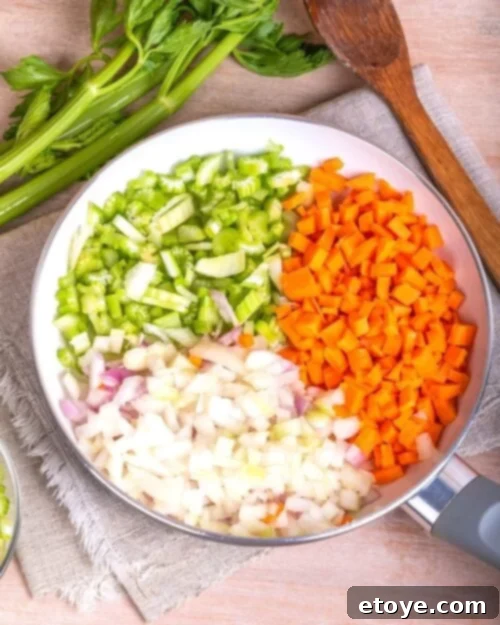Happy New Year, friends! As the calendar flips to a fresh start, there’s one cherished tradition we absolutely adore: celebrating and welcoming the new year with a heartwarming pot of black-eyed peas. Across the American South, this delicious legume is steeped in folklore, believed to usher in prosperity, good luck, and good fortune for the year ahead. Call us a little superstitious, but we embrace this delightful tradition wholeheartedly, especially since these humble peas taste incredibly delicious!
Our black-eyed pea recipe is a symphony of deep, fabulous flavors. It starts with a foundation of sautéed mirepoix—onions, carrots, and celery—gently cooked to coax out their aromatic essence. A touch of sweetness from ripe tomatoes, the savory depth of salty ham, and a burst of freshness from vibrant kale round out this robust dish. It’s more than just a meal; it’s a pot full of very lucky nourishment, promising a bountiful year to come.
Whether you’re celebrating a new year, looking for a comforting meal, or simply craving a taste of Southern tradition, this recipe for black-eyed peas with ham is sure to become a cherished favorite. Its rich flavors and wholesome ingredients make it a perfect centerpiece for any gathering, symbolizing hope and abundance.

The Enduring Tradition of Black-Eyed Peas for New Year’s
The practice of eating black-eyed peas on New Year’s Day is a deeply rooted tradition, especially prevalent in the Southern United States. This custom dates back centuries, with various explanations for its origins. One popular belief connects it to the Civil War, when Union soldiers pillaged Confederate food supplies, often leaving behind only dried peas, which were considered animal feed. These peas then became a symbol of survival and resourcefulness.
Another popular theory points to the “good luck” symbolism itself. The round shape of the peas is often said to symbolize coins or prosperity, while the act of eating them on the first day of the year is believed to ensure a financially successful twelve months. Often, they are served with collard greens, which represent folding money, and cornbread, representing gold. This trifecta of dishes is a powerful culinary charm for wealth and well-being. Regardless of its exact historical roots, the tradition has evolved into a beloved annual ritual, bringing families together over a warm, hearty meal that promises a year filled with good fortune.
Essential Ingredients for Black-Eyed Peas with Ham
Crafting the perfect pot of black-eyed peas with ham involves a selection of wholesome ingredients, many of which you might even have leftover from your holiday dinner, making this an excellent way to use up those delicious remnants!

- Dried Black-Eyed Peas: Naturally, these legumes are the star of our dish. While they vary slightly in size and the distinct “eye” color, their earthy flavor and creamy texture are consistent. Beyond their deliciousness, they are packed with fiber, protein, and essential nutrients, making them a fantastic addition to any diet. Opting for dried peas over canned allows for greater control over texture and seasoning, resulting in a more flavorful and authentic dish. They are, of course, the central component in the tradition of bringing prosperity and good luck in the New Year.
- Aromatic Vegetables (Mirepoix): The foundation of this dish’s deep flavor comes from the classic mirepoix—a simple yet powerful trio of onions, celery, and carrots. Sautéed in butter or olive oil, these vegetables are cooked gently to soften and release their aromatic compounds without caramelizing, building a sweet and savory base. We also incorporate fresh tomatoes for a subtle sweetness and a touch of acidity, which brightens the overall profile. For a generous boost of freshness and nutrients, we add vibrant kale. You can easily substitute kale with collard greens or turnip greens, which are equally traditional and complement the ham and peas beautifully. These greens not only add vital nutrients but also contribute to the symbolic “money” aspect of the New Year’s meal.
- Smoked Ham Bone, Ham Hocks, or Diced Ham: The ham is crucial for imparting that signature smoky, salty, and savory flavor that defines this dish. If you have a leftover ham bone from a holiday feast, it’s perfect for infusing the broth with incredible depth. Smoked ham hocks, readily available at most grocery stores, are another excellent choice, slowly simmering to release their rich essence and tender meat. Diced ham adds bursts of savory flavor throughout the peas. If you don’t have a ham bone, any pork bones will work wonderfully to build a robust flavor base. For those seeking a vegetarian option, smoked paprika and liquid smoke can be used to replicate the smoky flavor, alongside vegetable broth, ensuring everyone can enjoy this lucky dish.
- Garlic: Minced garlic adds a pungent, aromatic kick that complements the other vegetables and deepens the overall flavor profile.
- Water or Broth: The liquid base is essential for cooking the peas and developing the broth. While water works, using vegetable or chicken broth will add an extra layer of savory flavor.
- Salt: Essential for seasoning, but remember that ham products are often quite salty, so taste and adjust accordingly.
Crafting Your Lucky Pot of Black-Eyed Peas with Ham
Making black-eyed peas with ham is a straightforward process that rewards patience with incredibly flavorful results. Follow these steps for a perfect, comforting pot:
- Prepare the Black-Eyed Peas: Begin by rinsing your dried black-eyed peas thoroughly under cold water. Pick through them to remove any small stones or debris. For quicker cooking, you can use the rapid soak method: place the rinsed peas in a large pot, cover with water (at least 2-3 inches above the peas), and bring to a rolling boil. Boil for 2-3 minutes, then remove from heat, cover, and let them soak for 1 hour. Alternatively, for a gentler soak, you can simply cover them with water and let them sit overnight (8-12 hours) at room temperature. After soaking, drain the peas and discard the soaking water.
- Build the Flavor Base: In a large, heavy-bottomed pot or Dutch oven, heat a tablespoon of olive oil over medium-low heat. Add the diced onions, celery, and carrots (your mirepoix). Sauté these vegetables gently for 5-7 minutes, stirring occasionally, until they begin to soften but without browning or caramelizing. This step is crucial for building a sweet and aromatic foundation for your dish. Next, add the minced garlic and stir for another 2 minutes until fragrant. Be careful not to burn the garlic.
- Simmer with Ham and Peas: Once the aromatics are softened, add the ham bone and/or smoked ham hocks to the pot. Stir in the drained black-eyed peas. Pour in 6-8 cups of water or broth, ensuring everything is well-covered. Bring the mixture to a gentle simmer, then reduce the heat to low, cover the pot, and let it cook for at least 1 hour. During this time, the peas will begin to soften, and the ham will release its smoky, savory flavors into the broth, creating a rich base.
- Add Remaining Ingredients and Finish Cooking: After the initial hour of simmering, carefully remove the ham bone and ham hocks from the pot. If using ham hocks, you can pull any tender meat off the bones, shred it, and return it to the pot. Now, fold in the diced ham and the fresh diced tomatoes. Continue to simmer for another 30-40 minutes, or until the black-eyed peas are tender to your liking.
- Incorporate the Greens and Season: Finally, add the torn kale leaves (ensure tough stems are removed). Stir them into the black-eyed peas and cook for an additional 10 minutes, or until the kale is tender-crisp and vibrant green. If you’re using collard greens or turnip greens, which are tougher, add them at the same time as the diced ham and tomatoes, as they require a longer cooking time to become tender. Taste the peas and season with salt as needed. Remember that ham can be quite salty, so add salt gradually and taste as you go.


Sustainable Kitchen Tips for Your Black-Eyed Peas with Ham
Embracing a low-waste mindset in the kitchen not only benefits the environment but also enhances your cooking with richer flavors and smarter meal prep. Here are some tips specifically tailored for making black-eyed peas with ham:
- Elevate Your Stock Game: Don’t toss those vegetable scraps! Reserve carrot peels and tips, celery ends, and onion skins and ends. These seemingly insignificant pieces are packed with flavor and nutrients. Keep an ongoing “stock bag” in your freezer where you collect these scraps. When the bag is full, you have the perfect base for a homemade vegetable stock, which can then be used in future recipes, including your next batch of black-eyed peas. This enriches your dishes and reduces food waste simultaneously.
- Maximize Your Ham Scraps: Your ham hocks and ham bone are culinary gold! Instead of discarding them, consider their potential. They are excellent for making a deeply flavorful ham stock in a pressure cooker or slow cooker, which can be frozen and used as a base for soups, gravies, or other bean dishes. Alternatively, if you have canine companions, cooked ham bones (ensure they don’t splinter) can be a delightful treat, providing enrichment and a tasty reward for your furry friends. They’ll definitely be thanking you later!
- Utilize Kale Stems for Stock: When preparing your kale, simply rip the leafy greens away from the tough central stems. Don’t throw those stems out! Like other vegetable scraps, kale stems can be added to your freezer stock bag. These fibrous parts contribute a unique, slightly bitter, and earthy note to your homemade stocks, adding complexity and nutrients that would otherwise be wasted.
- Master Black-Eyed Pea Meal Prep: Black-eyed peas are incredibly versatile and freeze beautifully, making them ideal for meal prep. Once cooked and cooled, portion them into 1-2 cup servings in freezer-friendly bags or containers. Be sure to label each container with the contents, amount, and date. This way, you’ll have a healthy, hearty, and lucky meal component ready to go whenever you need a quick side dish, a protein boost for salads, or a base for new recipes. This saves time, reduces food waste from spoilage, and ensures you always have a nutritious option on hand.

Serving Suggestions for Your Black-Eyed Peas
Black-eyed peas with ham are a complete meal in themselves, but they truly shine when paired with traditional Southern accompaniments. Serve them hot alongside a generous slice of cornbread, perfect for soaking up the rich, savory broth. A sprinkle of fresh parsley or a dash of hot sauce can add a final flourish, balancing the flavors and adding a touch of heat. For an even heartier meal, consider serving them over a bed of fluffy white rice.
Black Eyed Peas with Ham Recipe
This traditional Southern recipe for black-eyed peas with ham promises good luck and prosperity for the New Year, alongside a truly delicious and comforting meal. You can soak the black-eyed peas overnight for ease, or use the quick soak method outlined in the recipe, which cuts the soaking time down to just 1 hour. This recipe is also perfect for a slow cooker; just remember not to add the greens until near the end of the cooking time to keep them vibrant and fresh – no one wants dull, lifeless greens for the New Year!
Print Recipe
Prep Time 8 mins
Cook Time 1 hr 40 mins
Servings 8
Ingredients
- 1/2 pound dried black-eyed peas
- 1 tablespoon olive oil
- 2 carrots, diced
- 2 stalks celery, diced
- 1/2 large onion, diced
- 2 cloves garlic, minced
- 2 smoked ham hocks
- 1 ham bone (or use any pork bones)
- 6-8 cups water
- 3 cups diced ham
- 1-2 large tomatoes, diced
- 5 handfuls torn kale leaves (tough stems removed)
- salt to taste
Instructions
- Rinse the black-eyed peas thoroughly, picking through them and discarding anything that’s not a bean. To soak, either cover in water and let sit overnight, or for a quicker method, place in a pot with water, bring to a rolling boil for 2-3 minutes, then turn off the heat and let sit in the hot water for 1 hour. Drain the peas and discard the soaking water.
- In a large, wide stockpot, heat the olive oil over medium-low heat. Sauté the diced carrots, celery, and onion for 5-7 minutes, stirring occasionally, until the vegetables are softened. Take care not to burn them. Add the minced garlic and sauté for an additional 2 minutes until fragrant.
- Add the ham bone, ham hocks, and the drained black-eyed peas to the pot. Top everything off with 6-8 cups of water. Bring the mixture to a simmer, then reduce the heat to low, cover the pot, and simmer for 1 hour.
- After 1 hour, remove the ham bone and ham hocks from the pot. If desired, pull any meat off the ham hocks and return it to the pot. Stir in the diced ham and diced tomatoes, then continue to simmer for an additional 30 minutes.
- Fold the torn kale leaves into the black-eyed peas and cook for 10 minutes, or until the leaves are tender-crisp. If using collard greens or turnip greens, add them with the diced ham and tomatoes as they require a longer cooking time. Taste the peas and season with salt to taste (the ham and hocks add quite a bit of salt, so adjust carefully).
Notes
Recipe adapted from Food Wishes.
Hungry for more New Year’s food? Check out some of our favorites here:
- Decadent Recipes Infused with Wine
- Salad with Warm Goat Cheese and Toasted Baguette
- Decadent Dessert Recipes using Cookie Dough
- Ribeye Cap Steak Dinner for Two
We truly hope you enjoy this flavorful and traditional black-eyed peas with ham recipe. May it bring you immense prosperity, vibrant health, and abundant joy throughout the coming year!
